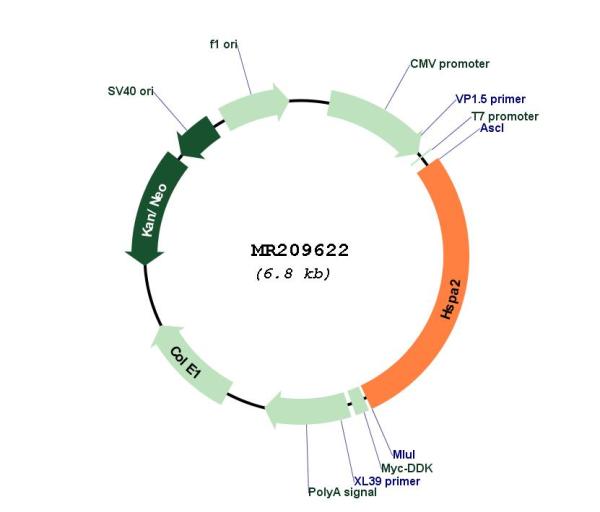Hspa2 (NM_008301) Mouse Tagged ORF Clone
CAT#: MR209622
- TrueORF®
Hspa2 (Myc-DDK-tagged) - Mouse heat shock protein 2 (Hspa2), transcript variant 1
ORF Plasmid: tGFP
Lentiviral Particles: DDK w/ Puro mGFP w/ Puro
"NM_008301" in other vectors (3)
Interest in protein/lysate? Submit request here!
Specifications
| Product Data | |
| Type | Mouse Tagged ORF Clone |
| Tag | Myc-DDK |
| Symbol | Hspa2 |
| Synonyms | 70kDa; Hsp70-2; HSP70.2; HSP70A2 |
| Vector | pCMV6-Entry |
| E. coli Selection | Kanamycin (25 ug/mL) |
| Mammalian Cell Selection | Neomycin |
| Sequence Data |
>MR209622 representing NM_008301
Red=Cloning site Blue=ORF Green=Tags(s) CTATAGGGCGGCCGGGAATTCGTCGACTGGATCCGGTACCGAGGAGATCTGCCGCCGCGATCGCCGGCGC GCCC ATGTCTGCCCGCGGCCCGGCTATCGGCATCGACCTGGGCACCACTTACTCGTGCGTGGGGGTATTCCAAC ATGGCAAGGTGGAGATCATCGCCAACGACCAGGGTAACCGCACCACCCCCAGCTACGTGGCCTTCACTGA CACCGAGCGTCTCATCGGCGACGCCGCCAAGAACCAAGTGGCCATGAACCCCACAAACACCATCTTCGAC GCCAAGCGGCTGATCGGACGGAAGTTCGAGGACGCCACAGTGCAGTCCGATATGAAGCACTGGCCGTTCC GAGTGGTGAGCGAAGGTGGGAAGCCCAAAGTGCAGGTGGAATATAAAGGGGAGATGAAGACCTTCTTCCC TGAGGAGATTTCTTCCATGGTCCTCACTAAGATGAAGGAGATCGCCGAAGCCTACCTGGGGGGCAAGGTG CAGAGCGCAGTCATCACTGTTCCTGCCTATTTCAACGACTCGCAGCGCCAGGCCACCAAGGATGCGGGCA CCATCACCGGCCTCAACGTGTTGCGCATCATCAATGAGCCCACAGCAGCGGCCATCGCCTACGGCCTGGA TAAGAAGGGCTGTGCGGGCGGCGAGAAGAACGTGCTCATCTTTGACCTGGGCGGGGGCACCTTCGATGTG TCCATCCTGACCATCGAGGATGGCATCTTTGAGGTGAAGTCCACGGCCGGCGATACCCACCTGGGTGGCG AAGACTTCGACAACCGTATGGTCAGCCACCTGGCGGAGGAGTTCAAGCGCAAACACAAGAAGGACATTGG GCCCAACAAGCGCGCTGTGCGCCGGCTGCGCACCGCCTGCGAGCGCGCTAAGCGCACCCTGAGCTCGTCC ACGCAGGCCAGCATAGAGATCGACTCGCTCTACGAGGGCGTGGATTTCTACACGTCCATCACCCGCGCCC GCTTCGAGGAGCTCAACGCCGATCTCTTCCGAGGGACCCTGGAGCCGGTGGAAAAGGCGCTGCGCGATGC CAAGCTAGACAAGGGCCAGATCCAGGAGATAGTGCTGGTGGGCGGCTCAACCCGCATCCCTAAGATCCAG AAGCTCCTGCAAGATTTCTTCAACGGCAAGGAGCTGAACAAGAGCATTAATCCCGACGAGGCGGTGGCCT ACGGCGCCGCTGTGCAGGCGGCTATCCTCATCGGCGACAAGTCGGAAAATGTGCAGGATCTGCTGTTACT CGACGTGACTCCATTGTCGCTCGGCATCGAAACAGCTGGCGGTGTCATGACCCCACTCATCAAGAGAAAC ACCACGATCCCCACCAAGCAGACGCAGACCTTCACTACCTACTCAGACAACCAGAGCAGCGTGCTGGTGC AAGTGTACGAGGGCGAACGGGCCATGACCAAGGACAATAACCTCTTGGGCAAGTTCGACCTGACTGGGAT CCCCCCAGCACCCCGTGGGGTCCCCCAGATCGAGGTCACCTTTGACATCGATGCCAACGGCATCCTTAAC GTCACTGCTGCCGACAAGAGCACCGGTAAAGAAAATAAAATCACCATAACCAACGACAAGGGTCGGCTGA GCAAAGACGACATTGACCGGATGGTGCAGGAGGCGGAGCGGTACAAATCGGAAGATGAAGCAAATCGCGA TCGCGTGGCAGCCAAAAATGCGGTGGAGTCCTATACCTACAACATCAAGCAGACCGTGGAAGACGAGAAA CTGAGGGGCAAGATTAGCGAGCAGGACAAAAACAAGATCCTCGACAAGTGTCAGGAGGTGATCAACTGGC TTGACCGAAACCAGATGGCAGAGAAAGATGAGTACGAACACAAGCAGAAAGAGCTTGAGAGAGTGTGCAA CCCCATCATCAGCAAACTTTACCAAGGCGGTCCAGGCGGCGGCGGCTCCTCTGGAGGGCCCACCATCGAG GAAGTGGAC ACGCGTACGCGGCCGCTCGAGCAGAAACTCATCTCAGAAGAGGATCTGGCAGCAAATGATATCCTGGATT ACAAGGATGACGACGATAAGGTTTAA >MR209622 representing NM_008301
Red=Cloning site Green=Tags(s) MSARGPAIGIDLGTTYSCVGVFQHGKVEIIANDQGNRTTPSYVAFTDTERLIGDAAKNQVAMNPTNTIFD AKRLIGRKFEDATVQSDMKHWPFRVVSEGGKPKVQVEYKGEMKTFFPEEISSMVLTKMKEIAEAYLGGKV QSAVITVPAYFNDSQRQATKDAGTITGLNVLRIINEPTAAAIAYGLDKKGCAGGEKNVLIFDLGGGTFDV SILTIEDGIFEVKSTAGDTHLGGEDFDNRMVSHLAEEFKRKHKKDIGPNKRAVRRLRTACERAKRTLSSS TQASIEIDSLYEGVDFYTSITRARFEELNADLFRGTLEPVEKALRDAKLDKGQIQEIVLVGGSTRIPKIQ KLLQDFFNGKELNKSINPDEAVAYGAAVQAAILIGDKSENVQDLLLLDVTPLSLGIETAGGVMTPLIKRN TTIPTKQTQTFTTYSDNQSSVLVQVYEGERAMTKDNNLLGKFDLTGIPPAPRGVPQIEVTFDIDANGILN VTAADKSTGKENKITITNDKGRLSKDDIDRMVQEAERYKSEDEANRDRVAAKNAVESYTYNIKQTVEDEK LRGKISEQDKNKILDKCQEVINWLDRNQMAEKDEYEHKQKELERVCNPIISKLYQGGPGGGGSSGGPTIE EVD TRTRPLEQKLISEEDLAANDILDYKDDDDKV |
| Chromatograms |
CHROMATOGRAMS
 Sequencher program is needed, download here. |
| Restriction Sites |
AscI-MluI
Cloning Scheme for this gene
Plasmid Map

|
| ACCN | NM_008301 |
| ORF Size | 1899 bp |
| OTI Disclaimer | The molecular sequence of this clone aligns with the gene accession number as a point of reference only. However, individual transcript sequences of the same gene can differ through naturally occurring variations (e.g. polymorphisms), each with its own valid existence. This clone is substantially in agreement with the reference, but a complete review of all prevailing variants is recommended prior to use. More info |
| OTI Annotation | This clone was engineered to express the complete ORF with an expression tag. Expression varies depending on the nature of the gene. |
| Product Components | The ORF clone is ion-exchange column purified and shipped in a 2D barcoded Matrix tube containing 10ug of transfection-ready, dried plasmid DNA (reconstitute with 100 ul of water). |
| Reconstitution | 1. Centrifuge at 5,000xg for 5min. 2. Carefully open the tube and add 100ul of sterile water to dissolve the DNA. 3. Close the tube and incubate for 10 minutes at room temperature. 4. Briefly vortex the tube and then do a quick spin (less than 5000xg) to concentrate the liquid at the bottom. 5. Store the suspended plasmid at -20°C. The DNA is stable for at least one year from date of shipping when stored at -20°C. |
| Reference Data | |
| RefSeq | NM_008301.4, NP_032327.2 |
| RefSeq Size | 2595 bp |
| RefSeq ORF | 1902 bp |
| Locus ID | 15512 |
| UniProt ID | P17156 |
| Cytogenetics | 12 33.73 cM |
| MW | 70.1 kDa |
| Gene Summary | Molecular chaperone implicated in a wide variety of cellular processes, including protection of the proteome from stress, folding and transport of newly synthesized polypeptides, activation of proteolysis of misfolded proteins and the formation and dissociation of protein complexes. Plays a pivotal role in the protein quality control system, ensuring the correct folding of proteins, the re-folding of misfolded proteins and controlling the targeting of proteins for subsequent degradation. This is achieved through cycles of ATP binding, ATP hydrolysis and ADP release, mediated by co-chaperones. The affinity for polypeptides is regulated by its nucleotide bound state. In the ATP-bound form, it has a low affinity for substrate proteins. However, upon hydrolysis of the ATP to ADP, it undergoes a conformational change that increases its affinity for substrate proteins. It goes through repeated cycles of ATP hydrolysis and nucleotide exchange, which permits cycles of substrate binding and release (By similarity). Plays a role in spermatogenesis (PubMed:24557841). In association with SHCBP1L may participate in the maintenance of spindle integrity during meiosis in male germ cells (PubMed:24557841).[UniProtKB/Swiss-Prot Function] |
Documents
| Product Manuals |
| FAQs |
| SDS |
Resources
Other Versions
| SKU | Description | Size | Price |
|---|---|---|---|
| MG209622 | Hspa2 (tGFP-tagged) - Mouse heat shock protein 2 (Hspa2), transcript variant 1 |
USD 789.00 |
|
| MR209622L3 | Lenti ORF clone of Hspa2 (Myc-DDK-tagged) - Mouse heat shock protein 2 (Hspa2), transcript variant 1 |
USD 889.00 |
|
| MR209622L4 | Lenti ORF clone of Hspa2 (mGFP-tagged) - Mouse heat shock protein 2 (Hspa2), transcript variant 1 |
USD 889.00 |
{0} Product Review(s)
Be the first one to submit a review






























































































































































































































































 Germany
Germany
 Japan
Japan
 United Kingdom
United Kingdom
 China
China


